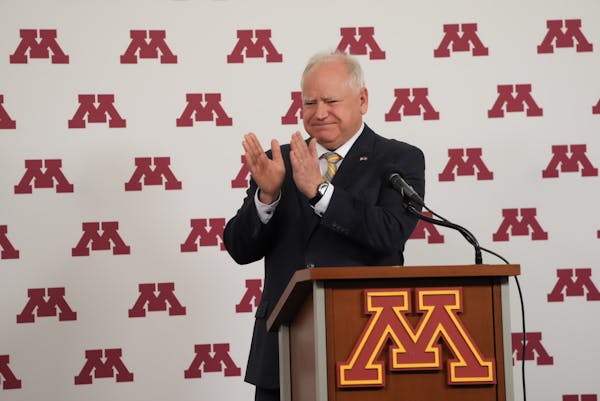Back in high school, Jenna Perkins brought an infectious vibe to every flag football field, track oval, basketball court and bowling alley that she set foot on. That's still her role.
"I get everyone hyped," the Special Olympics athlete says, pumping her palms into the air.
And her pal Danny Striggow has been right along with her.
"Jenna knows how to get the crowd going, that's for sure," said Striggow, a former state high school wrestling champion who now plays football for the University of Minnesota. "She's like the Energizer Bunny. You can feel it when she enters the field — her constant energy, being able to put a smile on someone's face, just like that."
Their friendship developed at Orono High School because of the advent of what's known as unified sports and clubs. Its rise represents the most significant shift in the 50 years that Special Olympics Minnesota has been in existence, according to its president and CEO, Dave Dorn.
When the organization started in 1973, its focus was on expanding opportunities for people with disabilities, often through athletic competitions of their own. The unified movement brings together people with and without intellectual disabilities playing on the same team and working toward a common goal. Unified sports was launched in 1988, but it has exploded over the past decade within school programming.
That's how Perkins and Striggow — not to mention a good chunk of his varsity football buddies — found themselves doing choreographed kicklines alongside each other during halftime at basketball games.
"Half the football team was trying out for unified dance because it was so much fun," Striggow said. "I don't think there are negative reviews. Once you interact with a Special Olympics event, you come back."
The beauty of unified sports is that students with disabilities and those without are working as a team, having fun, and perhaps sharing the thrill of victory or the agony of defeat. They're paired against teams of similar makeup and abilities, so games are competitively matched.
The model moves past acceptance. It's about inclusion.
Dorn recalls his daughter, who has special needs, had a much different experience when she went to school many years ago.
"She loved high school, was very active, had a lot of friends in the halls, and everyone was super-accepting, but no one ever called our house after school to go to a bonfire or do anything else," Dorn said. "That was true for almost everybody who had an intellectual disability. The advent of unified sports is changing the whole dynamic."
Special Olympics Minnesota started with just a handful of "unified champion" schools in 2014. Now there are about 300. Some athletes have Down syndrome or other genetic conditions. Others may be on the autism spectrum. And about half of the participants have no disability at all.
"If you come to our tournaments, you might not even know who has an intellectual disability and who doesn't," he said. "People find that Special Olympics is a great place for anybody."
If there's an agenda, this is it: planting the seeds for a more inclusive society.
After graduation, many of these students will dive into the workforce and become leaders in their communities. They'll already know what true belonging looks like. They'll be able see the potential of their peers, not just their disabilities, Dorn said.
Perkins, the daughter of former KARE 11 sports anchor Eric Perkins, still participates in unified activities, now as a student at Bethel University in Arden Hills. The 19-year-old is a member of the two-year BUILD program for students with intellectual and developmental differences. She just finished bowling, but said one of her favorite sports is basketball.
"I love my team," she said. "You make new friends. And I am a great leader."
Striggow, 21, graduates from the U this month. He will start his graduate program in human resource development and play football for another year. He says unified sports has allowed him to see that everyone can be led, albeit in different ways. And he credits Special Olympics for changing his perspective as a player and a human.
"At any event, all you see is smiles," he says. "They're not focusing on what they can't do, but what they can do. An outsider might come in and say, 'They're so unfortunate.' But it's not seen that way. It's seen as, 'This is what I can do, and I'm going to have a blast doing it.' "
Today, both Perkins and Striggow are teaming up for another big undertaking. They are honorary co-chairs of the 2026 Special Olympics USA Games, which are coming to Minnesota. The events are expected to draw 4,000 athletes and 75,000 fans.
For Perkins and Striggow, being ambassadors for the games means lots of hand-shaking with elected officials and corporate VPs, speechifying and evangelizing on the possibilities of inclusion.
But Perkins and Striggow already know about that. Their friendship speaks volumes about the power of coming together.
Yuen: The bizarre and relatable case of Minnesota state Sen. Nicole Mitchell

Yuen: Lynx No. 1 pick Pili finds 'blessing' fueling dreams of Samoan, Indigenous kids

Yuen: Why do people forgive? It's messy, complex and 'the best form of self-interest'

Your fridge is a place where fresh food goes to die. That doesn't have to happen.



